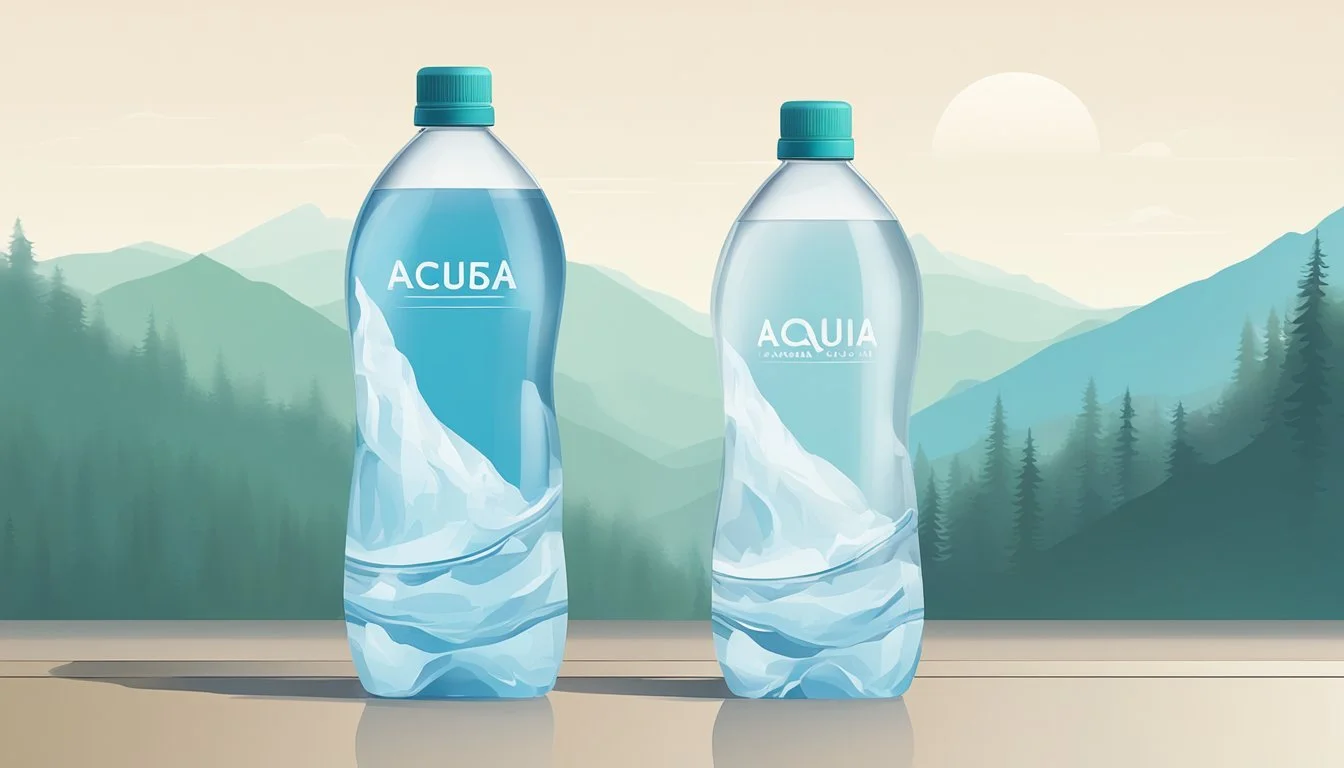Acqua Pana vs. Cascade Mountain
A Comparative Analysis
Comparing bottled waters often comes down to nuances in taste, source, and mineral content. Acqua Panna, sourced from Tuscany, is celebrated for its smooth and light taste, hinting at the region's unique geological composition. In contrast, Cascade Mountain spring water offers a crisp, refreshing flavor, sourced from the pristine Cascade Range, renowned for its natural purity.
For those seeking a balanced flavor profile with a hint of Mediterranean mineral smoothness, Acqua Panna stands out. Its consistent quality and mineral-rich content make it a favorite among those who prefer a subtler taste. Meanwhile, Cascade Mountain appeals to those who enjoy a more robust, crisp drinking experience. This makes it ideal for hydration during outdoor activities where refreshment is key.
Choosing between Acqua Panna and Cascade Mountain ultimately hinges on personal preference. If a smooth, velvety water profile is appealing, Acqua Panna is the go-to. For those who prioritize a clean, invigorating taste, Cascade Mountain may be the better option.
Understanding Bottled Water
When it comes to selecting bottled water, there are various types, safety standards, and comparisons to tap water that must be considered. This guide dives into the essential aspects that determine the quality and suitability of bottled water for consumers.
Types of Bottled Water
Bottled water is categorized into different types based on its source and treatment method. Spring water comes from natural springs and is rich in minerals. Mineral water contains natural minerals and electrolytes, making it beneficial for replenishment. Purified water undergoes processes like reverse osmosis to remove impurities, resulting in very clean water. Alkaline water has a higher pH level, often above 7, and may help balance the body's pH levels. Each type offers unique benefits and serves different preferences and health needs.
Regulations and Safety Standards
Bottled water production is regulated to ensure safety and quality. In the United States, the Food and Drug Administration (FDA) enforces standards similar to those set by the Environmental Protection Agency (EPA) for tap water. Regulations cover source protection, treatment, and bottling operations to prevent contamination. Additionally, bottled water is subjected to regular testing for contaminants and must meet specific microbiological and chemical standards. Labels must accurately reflect the water's source and contents, providing consumers with transparent information.
Bottled Water vs. Tap Water
The choice between bottled water and tap water often comes down to preference and perception. Tap water is regulated by the EPA and is widely available at a lower cost. However, bottled water is perceived to be purer and more convenient. Bottled water often contains added minerals for taste and health benefits and is available in various types that meet specific demands such as higher pH levels or additional antioxidants. Both options must adhere to safety standards, but bottled water offers an additional layer of quality assurance through regulated bottling processes.
The Source Matters
The origin of bottled water plays a crucial role in determining its quality and taste. Below, we explore the natural spring water origins and aquifer protection of both Acqua Panna and Cascade Mountain to understand their unique characteristics.
Natural Spring Water Origins
Acqua Panna originates from the picturesque region of Tuscany, Italy. This area is known for its rich history and pristine environment, contributing to the water’s smooth, balanced taste. The water is naturally filtered through the Apennine Mountains, which enhances its mineral content.
Cascade Mountain, on the other hand, comes from natural springs located in the Cascade Range, Oregon. These springs are fed by rainwater and snowmelt, resulting in a refreshing water profile. The unique geological conditions of the Cascades impart a distinct mineral composition, setting it apart from other bottled waters.
Aquifer Protection and Groundwater
Both Acqua Panna and Cascade Mountain take aquifer protection seriously to maintain the purity of their groundwater sources. In Tuscany, Acqua Panna's source is protected by over 3,000 hectares of land, ensuring minimal human impact and environmental preservation. This vast protected area helps maintain the water’s natural balance and cleanliness.
Cascade Mountain’s springs benefit from the remote and untouched nature of the Cascade Range. The aquifers there are under constant monitoring and management to prevent contamination. Stringent regulations and sustainable practices are employed to safeguard the groundwater, retaining its high quality and natural purity.
These factors highlight the importance of origin and aquifer protection in delivering a premium bottled water experience.
Acqua Panna: An Italian Excellence
Acqua Panna is celebrated for its exceptional quality and historic roots in Tuscany, Italy. From its origins on the Panna Estate to its well-balanced mineral composition, this water exemplifies Italian craftsmanship in bottled water.
Historical Background
Acqua Panna traces its history back to the 16th century, originating from the Panna Estate in Tuscany. The Medici family, renowned patrons of the arts and sciences, initially discovered and cherished the spring water.
They valued it for its purity and refreshing taste. Over the centuries, Acqua Panna has maintained its reputation, owing much to the region's commitment to high standards in water quality and sustainability practices.
Panna Estate and Tuscany's Contribution
The Panna Estate, located in Tuscany's rolling hills, provides an ideal setting for sourcing premium mineral water. The estate spans over 1,300 hectares, with natural springs filtering through the Apennine Mountains. This natural filtration process contributes to Acqua Panna’s clean and smooth taste.
Tuscany’s contribution extends beyond just the water source. The region’s dedication to preserving the environment ensures sustainable water practices, making Acqua Panna a responsible choice for eco-conscious consumers.
Mineral Compositions and Quality
The mineral composition of Acqua Panna distinguishes it in the market. With a neutral pH balance around 8.0, it is ideal for those seeking a smooth, subtle flavor profile. Minerals like calcium, magnesium, and bicarbonate are balanced, contributing to its soft texture.
Quality reports consistently highlight the purity of Acqua Panna, confirming its low sodium content and absence of harmful contaminants. This ensures that consumers enjoy not only a refreshing but also a safe drinking experience.
Cascade Mountain: Pure American Source
Cascade Mountain offers bottled water sourced from a pristine environment in the United States. This section delves into the origin, taste, and environmental impacts of this popular brand.
Spring Source and Location
Cascade Mountain water is sourced from natural springs in the Cascade Mountains, a series of mountain ranges in the Pacific Northwest. The springs are located in remote, untouched areas, ensuring water purity from inception.
These springs are fed by rainfall and snowmelt, filtered through layers of volcanic rock, which contributes to the water's high mineral content.
Taste and Purity
Cascade Mountain water is renowned for its crisp, clean taste. The natural filtration process through volcanic rock adds essential minerals, enhancing the flavor. Many consumers describe the water as having a refreshing, slightly sweet aftertaste.
The mineral composition strikes a balance that is neither overwhelming nor bland, making it a favorite choice for those who appreciate a pure and natural beverage.
Environmental Considerations
Cascade Mountain places a strong emphasis on environmental sustainability. The company employs eco-friendly bottling practices, using recyclable materials to minimize waste.
Efforts are also made to protect the natural springs and surrounding habitats, ensuring long-term water quality and availability. Additionally, Cascade Mountain invests in renewable energy sources to power their facilities, reducing their carbon footprint.
Taste Test: A Comparative Analysis
A comparison of Acqua Panna and Cascade Mountain reveals differences in flavor profiles and expert opinions. Both brands have their unique characteristics influenced by their mineral compositions.
Flavor Profiles
Acqua Panna, sourced from Tuscany, is often noted for its smooth taste and subtle mineral flavors. The water has a neutral pH of around 8.0, contributing to a balanced, slightly alkaline experience.
In contrast, Cascade Mountain water is thought to have a crisper, more invigorating flavor. This spring water from the Cascade Range in Oregon has a pH close to 7.0, which is neutral. Tasters frequently mention its purity and refreshing qualities, with a light mineral taste that speaks of its mountainous origin.
Here is a comparison table:
Brand Source Flavor Notes pH Level Acqua Panna Tuscany, Italy Smooth, subtle minerals 8.0 Cascade Mountain Cascade Range, USA Crisp, refreshing, light minerals 7.0
Water Sommelier Insights
Water sommeliers provide expert reviews on the nuances of each brand. They appreciate Acqua Panna for its silky texture and the way it leaves a clean finish on the palate. The balanced mineral composition lends a softer taste, making it a preferred choice for pairing with fine dining.
Cascade Mountain water, with its more pronounced crispness, is often praised for its excellent thirst-quenching properties. Sommeliers highlight its refreshing qualities and how it invigorates the senses. The slightly higher minerality from its mountainous source enhances its bold, fresh flavor profile, making it a favorite for everyday hydration.
In summary, these insights reveal the distinctive appeal of each brand’s water taste, influenced by their unique mineral compositions and pH levels.
Health and Hydration Benefits
Both Acqua Panna and Cascade Mountain bottled waters offer distinct advantages when it comes to essential minerals, hydration effectiveness, and pH levels. Understanding these benefits can help consumers make more informed choices about their drinking water.
Essential Minerals and Electrolytes
Acqua Panna, sourced from the Tuscan hills of Italy, contains natural minerals like calcium and magnesium. These minerals contribute to overall bone health and support various bodily functions, including muscle performance and nerve function.
Cascade Mountain water also provides essential minerals, with noteworthy levels of potassium and calcium. These minerals are vital for maintaining heart health and electrolyte balance. While the mineral content can vary, it is generally well-balanced to support daily nutritional needs.
Both brands ensure that consumers receive beneficial minerals with each sip, enhancing daily hydration and offering additional health benefits.
Hydration Effectiveness
Hydration is crucial for maintaining bodily functions and overall health. Acqua Panna is praised for its smooth texture, which can encourage more frequent drinking. Its mineral composition aids in quick absorption, making it a reliable choice for continuous hydration throughout the day.
Cascade Mountain water is renowned for its light and refreshing taste. This makes it appealing for regular consumption, ensuring consistent hydration. Its balanced mineral content supports efficient fluid retention and optimal bodily hydration.
Both waters effectively quench thirst and support the body's hydration needs, though personal taste preference might influence an individual's choice.
PH Levels and Alkalinity
The pH level of water can impact its taste and its effect on the body. Acqua Panna maintains a slightly alkaline pH of around 8.0. Alkaline water is believed to aid in neutralizing acidity in the body and improving metabolic functions.
Cascade Mountain water has a pH range typically between 7.3 and 7.7. This range is close to the body's natural pH balance and ensures that the water is easily processed by the body.
Both brands provide water that is gentle on the system, aiding in maintaining an optimal internal pH balance, which is a key factor in achieving overall wellness.
Environmental Impact and Sustainability
The environmental impact of bottled water brands can significantly differ based on their packaging and sustainability initiatives. This section examines how Acqua Panna and Cascade Mountain handle these crucial aspects.
Packaging and Plastic Usage
Packaging is a significant factor in assessing a bottled water brand’s environmental impact. Acqua Panna offers its water in both glass and plastic bottles, catering to diverse consumer preferences. Their glass bottles are often favored for being more environmentally friendly since glass is highly recyclable and reusable.
Cascade Mountain, on the other hand, primarily uses plastic bottles. These plastic containers are made from PET (polyethylene terephthalate), which is recyclable but still contributes to environmental pollution if not disposed of properly.
Both brands' use of packaging materials indicates their differing approaches to sustainability, with Acqua Panna leaning more towards eco-friendly options.
Water Brand Commitments
Water brands often highlight their commitments to sustainability and environmental stewardship. Acqua Panna emphasizes its efforts to source water sustainably from its spring in Tuscany, ensuring minimal environmental disruption. They have taken steps to reduce their carbon footprint through energy-efficient practices in their bottling facilities.
Cascade Mountain is also taking steps toward sustainability by implementing eco-friendly practices in their production processes. They aim to minimize their carbon emissions and reduce the use of non-renewable resources in their operations.
These commitments from both brands show their dedication to reducing environmental impact and promoting sustainable practices.
The Role of Recycling
Recycling plays a crucial role in managing the environmental impact of bottled water packaging. Acqua Panna has initiatives to encourage consumers to recycle their bottles, especially those made of glass, which have a higher recycling rate compared to plastic.
Cascade Mountain encourages the recycling of their plastic bottles by indicating clear recycling instructions on the packaging. They are also exploring the use of recycled materials in their bottle production to close the loop on plastic waste.
A comparison table might help illustrate this:
Brand Bottle Types Recycling Initiatives Acqua Panna Glass, Plastic Encourages glass recycling, uses recycled materials Cascade Mountain Plastic Clear recycling instructions, exploring use of recycled plastic
Both brands' efforts underscore the importance of consumer participation in recycling to mitigate environmental impact.
Conclusion: Choosing Your Water Wisely
When comparing Acqua Panna and Cascade Mountain, each offers distinct characteristics worth considering.
Acqua Panna, sourced from Tuscany, is known for its smooth taste attributed to the region's unique geological composition. This bottled water brand boasts a neutral pH of about 8.0, appealing to those seeking a balanced dietary pH.
Cascade Mountain, on the other hand, emphasizes its purity and refreshing profile, sourced from natural springs. The brand's quality reports highlight a clean, crisp taste that many find appealing.
Key Factors to Consider:
Taste: Acqua Panna's smooth profile vs. Cascade Mountain's crisp and refreshing quality.
Source: Tuscany, Italy for Acqua Panna vs. natural springs for Cascade Mountain.
pH Level: Neutral pH around 8.0 for Acqua Panna vs. varying levels for Cascade Mountain.
Quality Reports: Reliable brands with consistent quality control measures.
Both Acqua Panna and Cascade Mountain are reliable brands in the bottled water market. Preferences may vary based on taste, source, and pH level.






